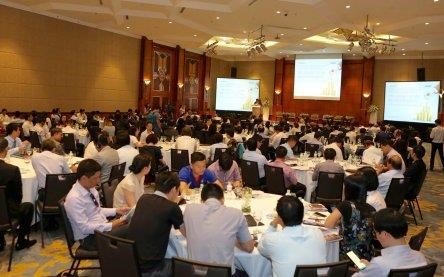At a recent workshop on prospects for the Vietnamese economy in 2018 and to 2020, Minister of Planning and Investment Nguyen Chi Dung said the country will benefit from the recovery of the world economy this year and there are many reasons to be optimistic about domestic economic growth from now to 2020.
    |
 |
|
Participants at the workshop |
The advisory group to the Prime Minister on economic affairs said economic development in the recent past was driven by reform efforts with drastic measures, which improved the business and investment environment, along with flexible and coordinated macro-economic policies and the effect of new policies such as developing the private sector.
The group devised three scenarios for Vietnam’s economic growth in 2018-2020, which envision annual average GDP growth rate at 6.7 percent, 6.83 percent and 7.47 percent, respectively. The group also proposed the target of an average annual growth of 6.85 percent for the next three years (2018 to 2020).
The forecast demonstrates economists’ optimistic viewpoint of the country’s economic prospects.
However, in-depth analysis of Quarter 1 economic performance also revealed potential problems, participants at the workshop said.
It is noteworthy that the high economic growth in Q1 was driven by the manufacturing sector, especially big foreign-invested enterprises such as electronics manufacturer Samsung Vietnam and steel maker Formosa Ha Tinh. The question is whether those enterprises will be able to maintain the high growth rate in following quarters in the context of unforeseeable factors in the world economy such as the trade protection policy of the US and the risk of a US-China trade war.
Economist Le Xuan Nghia said the manufacture sector is currently dominated by foreign-invested enterprises, and the domestic enterprises are saddled with high interest rates, logistic costs and informal expenses.
In particular, the enforcement of laws and policies is not strict enough, many documents guiding the execution of laws and decrees are inconsistent, incomplete and lack transparency, and administrative procedures, especially those related to land and investment in capital construction, reveal many shortcomings.
PHan Duc Hieu, Deputy Director of the Central Institute for Economic Management, was of the opinion that despite certain results, the pace of institutional reform is still slow and fails to meet expectations of the business community.
The restructuring of the economy also fell short of expectations, Hieu said.
He added that it is necessary to change the way of thinking not only among policy makers but also those who implement the policies.
“Changing the way of thinking throughout the administrative apparatus is an important content of institutional reform,” Hieu said.
Minister of Planning and Investment Nguyen Chi Dung shared the view on the need to accelerate institutional reform.
“This is the fundamental driving force of economic growth, which is both an urgent need in the context of rapid changes and a requirement for development,” he said.
Speaking on the Government’s reform priorities, the minister also highlighted the need to increase labour productivity, stressing that this is the most important factor in improving growth quality and renewing the growth model.
According to the Minister, the most effective way to enhance labor productivity is to capture opportunities brought about by the 4th Industrial Revolution.
“This opportunity is one-in-a-million,” Dung said.
He also mentioned other factors that can contribute to economic growth, such as infrastructure and human resources.
“There is plenty of room for improvement, and the question is how to improve in the most rapid and effective manner,” the minister said.
He agreed that in spite of the optimism, challenges and difficulties should not be overlooked.
Source: VNA